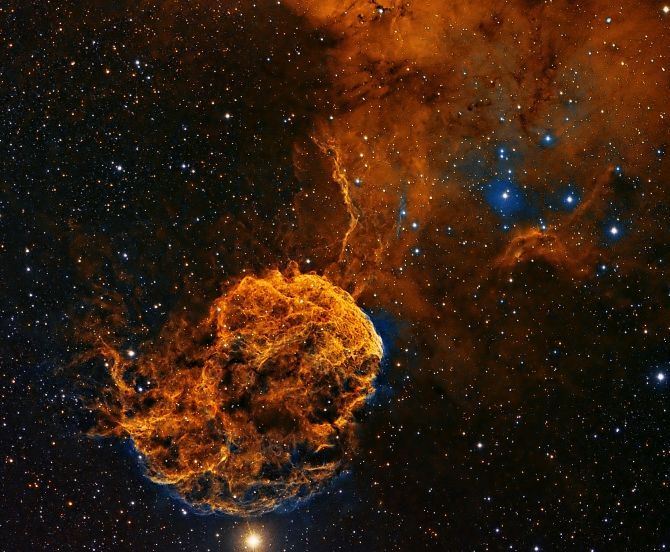Jaw-dropping celestial views of the Milky Way, Northern Lights, and comets hurtling through space are just some of the incredible images to have made the shortlist for the 2015 Insight Astronomy Photographer of the Year competition.
The competition run by the Royal Observatory Greenwich in association with Insight Investment and BBC Sky at Night Magazine, is now in its seventh year and continues to go from strength to strength, receiving a record number of over 2,700 spectacular entries from enthusiastic amateurs and professional photographers from over 60 countries spanning the globe.
Here are some of the best!
Motind

Careening over the peaks of Senja, oxygen produces the greens and nitrogen the purples, seen in this particular display of the Northern Lights. Photograph: Rune Engebo
Ascent of Angels

A meteor can be seen piercing through the darkness as the Milky Way towers above the 4,392m peak of Mount Rainier in Washington, USA. The white lights dotted across the rocky paths of the mountain’s face are the headlamps of hikers ascending to the peak. Photograph: Brad Goldpaint
Great Nebula in Carina Bi-Colour

The hypergiant star Eta Carinae glows against the background of swirling clouds of dust and gases that form the Carina Nebula. The Carina Nebula is one of the largest diffuse nebulae - meaning that it has no well-defined boundaries - in our skies and is about four times as large as the famed Orion Nebula. Photograph: Terry Robison
C/2014 Q2 Lovejoy

Comet Lovejoy sails through the solar system in a green haze, leaving cometary dust in its wake. Photograph: Michael Jaeger
Herschel 36: The Heart of the Lagoon

Situated some 5,000 light years away, the stellar nursery of the Lagoon Nebula lies in the constellation of Sagittarius. Despite being light years away, the Lagoon Nebula is in fact one of the few star-forming nebulae that it is possible to see with the naked eye (in optimum conditions) from mid-northern latitudes. Photograph: László Francsics
IC443

Lying in the constellation of Gemini, IC443 is a galactic supernova remnant, a star that could have exploded as many as 30,000 years ago. Its globular appearance has earned the celestial structure the moniker the Jellyfish Nebula. Photograph: Patrick Gilliland
The Mirrored Night Sky

An enthralled stargazer is immersed in the stars as the luminous purple sky is mirrored in the thin sheet of water across the world’s largest salt flat, Salar de Uyuni, in Bolivia. Photograph: Xiaohua Zhao
Roseta-NBv5

Measuring 50 light years in diameter, the large, round Rosette Nebula is found on the edge of a molecular cloud in the constellation of Monoceros the Unicorn. At the core of the nebula the very hot young stars have heated the surrounding gaseous shell to a temperature in the order of 6 million kelvins, resulting in the emission of copious amounts of X-rays. Photograph: Juan Ignacio Jimenez
Star Trails over Green Lake

Star trails illuminate the night sky over a campfire-lit GreenLake in the Hoover Wilderness of California. Photograph: Dan Barr
The Edge of the Aurora

A rare sighting of a red aurora, caused by the emission of high-altitude oxygen, captured on film, dancing over the small fishing town of Eyrarbakki, on the south coast of Iceland. The result of a large geomagnetic storm caused by a large coronal mass ejection. Photograph: Chul Kwon
Thor’s Helmet (NGC 2359)

The distinctive shape of the nebula NGC 2359 has led to it also being known as Thor’s Helmet, as it resembles the headgear of the Norse God (and Marvel superhero). Around 11,000 light years away, the overall bubble shape is mainly due to interstellar material swept up by the winds of the nebula’s central star, Wolf-Rayet, an extremely hot giant thought to be in a pre-supernova stage. Photograph: Adam Block
Solar Prominence

Searing hot loops of plasma radiate from the edge of our local star – the sun – in a phenomenon known as a solar prominence. Emanating from the sun’s outer shell, from which light is emitted, prominences extend to the corona, which is the aura of the plasma surrounding it. A typical prominence covers over thousands of kilometres, with the largest ever recorded estimated to be over 800,000 kilometres, equalling roughly the radius of the sun itself. Photograph: Gary Palmer










